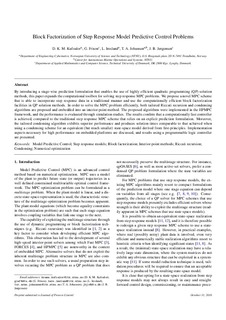| dc.contributor.author | Kufoalor, D. Kwame Minde | |
| dc.contributor.author | Frison, Gianluca | |
| dc.contributor.author | Imsland, Lars Struen | |
| dc.contributor.author | Johansen, Tor Arne | |
| dc.contributor.author | Jørgensen, JB | |
| dc.date.accessioned | 2017-12-13T11:18:45Z | |
| dc.date.available | 2017-12-13T11:18:45Z | |
| dc.date.created | 2017-10-17T15:32:53Z | |
| dc.date.issued | 2017 | |
| dc.identifier.citation | Journal of Process Control. 2017, 53 1-14. | nb_NO |
| dc.identifier.issn | 0959-1524 | |
| dc.identifier.uri | http://hdl.handle.net/11250/2471093 | |
| dc.description.abstract | By introducing a stage-wise prediction formulation that enables the use of highly efficient quadratic programming (QP) solution methods, this paper expands the computational toolbox for solving step response MPC problems. We propose a novel MPC scheme that is able to incorporate step response data in a traditional manner and use the computationally efficient block factorization facilities in QP solution methods. In order to solve the MPC problem efficiently, both tailored Riccati recursion and condensing algorithms are proposed and embedded into an interior-point method. The proposed algorithms were implemented in the HPMPC framework, and the performance is evaluated through simulation studies. The results confirm that a computationally fast controller is achieved, compared to the traditional step response MPC scheme that relies on an explicit prediction formulation. Moreover, the tailored condensing algorithm exhibits superior performance and produces solution times comparable to that achieved when using a condensing scheme for an equivalent (but much smaller) state-space model derived from first-principles. Implementation aspects necessary for high performance on embedded platforms are discussed, and results using a programmable logic controller are presented. | nb_NO |
| dc.language.iso | eng | nb_NO |
| dc.publisher | Elsevier | nb_NO |
| dc.rights | Attribution-NonCommercial-NoDerivatives 4.0 Internasjonal | * |
| dc.rights.uri | http://creativecommons.org/licenses/by-nc-nd/4.0/deed.no | * |
| dc.title | Block factorization of step response model predictive control problems | nb_NO |
| dc.type | Journal article | nb_NO |
| dc.type | Peer reviewed | nb_NO |
| dc.description.version | acceptedVersion | nb_NO |
| dc.source.pagenumber | 1-14 | nb_NO |
| dc.source.volume | 53 | nb_NO |
| dc.source.journal | Journal of Process Control | nb_NO |
| dc.identifier.doi | 10.1016/j.jprocont.2017.02.003 | |
| dc.identifier.cristin | 1505297 | |
| dc.relation.project | Norges forskningsråd: 215684 | nb_NO |
| dc.relation.project | Norges forskningsråd: 223254 | nb_NO |
| dc.description.localcode | © 2017. This is the authors’ accepted and refereed manuscript to the article. Locked until 27.2.2019 due to copyright restrictions. This manuscript version is made available under the CC-BY-NC-ND 4.0 license http://creativecommons.org/licenses/by-nc-nd/4.0/ | nb_NO |
| cristin.unitcode | 194,63,25,0 | |
| cristin.unitname | Institutt for teknisk kybernetikk | |
| cristin.ispublished | true | |
| cristin.fulltext | postprint | |
| cristin.qualitycode | 2 | |

